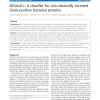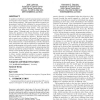883 search results - page 176 / 177 » Unsupervised learning in neural computation |
INFORMS
1998
13 years 5 months ago
1998
The problem of discriminating between two nite point sets in n-dimensional feature space by a separating plane that utilizes as few of the features as possible, is formulated as a...
ISCAS
2006
IEEE
13 years 11 months ago
2006
IEEE
Abstract—We present a silicon neuron that uses shunting inhibition (conductance-based) with a synaptic rise-time to achieve synchrony. Synaptic rise-time promotes synchrony by de...
BMCBI
2011
13 years 20 days ago
2011
Background: Most predictive methods currently available for the identification of protein secretion mechanisms have focused on classically secreted proteins. In fact, only two met...
MSR
2006
ACM
13 years 11 months ago
2006
ACM
With the advent of open source software repositories the data available for defect prediction in source files increased tremendously. Although traditional statistics turned out t...
GECCO
2010
Springer
13 years 9 months ago
2010
Springer
A significant challenge in genetic programming is premature convergence to local optima, which often prevents evolution from solving problems. This paper introduces to genetic pro...


